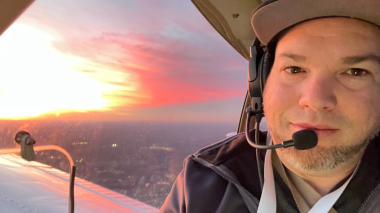In July 2018, 56-year-old Scott Gilpin was traveling home to Florida from his 30th wedding anniversary trip in Hawaii. After lifting heavy luggage into his rental car, he felt a pain in his stomach.
A number of doctor visits and series of blood tests confirmed Scott had a hernia. A week later, he was scheduled for what was supposed to be a routine surgery at a hospital in Florida—or so he thought it would be routine.
The surgery was unsuccessful, leaving his hernia unrepaired in addition to a new puncture made in his small intestine. Follow up surgeries were done at the same hospital, which also did not go according to plan, according to Scott.
Routine surgery turns into chronic issues
The series of failed surgeries landed Scott in his hometown hospital for five months, and another month off and on after his first admission. In addition, during his stay he acquired sepsis, a life-threatening blood infection, twice. A portion of his intestine protruded through his abdominal wall, causing any food he consumed to seep through the opening—leaving him unable to eat for months on end.
Once an active runner, swimmer, and biker, Scott’s limitations caused him to become a shell of his former self.
Once he was back home more permanently, he was confined to his fluid bag day and night. When he was out and about, he had to worry about his stomach leaking.
“Life as I knew it was really over,” Scott says. “Even the simplest tasks were extremely difficult to perform. Imagine getting up every day and carrying a backpack full of dressing changes and extra clothes because at any moment the bag or the dressing would leak.”
Scott depended solely on total parenteral nutrition (TPN) for survival, a method of receiving nutrition via a port in his arm. He was moved to the Intensive Care Unit and fought battle after battle with complications, blood clots, and sepsis—a life-threatening bodily reaction to infection.
“I was seeing the same doctor in Florida every week, hoping things would change,” says Scott. “And the problem is sometimes if you're a loyal person, you just fall into this rut and get in the car and go see the doctor every Tuesday and hope things will change— but nothing changed. And I guess you're in, at least for me, I was in a state of despair.”
A search for answers leads to care at Atrium Health
Scott was hoping and praying for a change. He started looking feverishly for alternative options.
With little luck, Scott attempted treatment in a hyperbaric chamber located in his home state to cure the wound. During his treatment at the wound care center, he sought the advice of the in-house doctor.
“And once he took a look at me, just kind of shook his head and said, ‘oh my God, you're in bad shape,’ not that I didn’t know it,” said Scott. “He said, ‘there's really only one way to fix this,’ and he referred me to Dr. Heniford.”
Dr. B. Todd Heniford, Atrium Health world-renowned surgeon and founder and chief of the Division of Gastrointestinal and Minimally Invasive Surgery, spearheaded Scott’s care. The team at the Carolinas Hernia Institute maintains one of the largest single center hernia databases in the world—meaning they track patients, with permission, years after their procedures in order to gain insights used to constantly improve patient outcomes. The program was the first in the world to pioneer a life scoring system post-hernia repair, which has now been used in more than 50 countries, in 30 different languages.
Among these and other contributions, it’s the reason patients like Scott travel to Atrium Health from all over the country –and the world – for successful, lasting hernia repair.
Dr. Heniford vividly recalls the first time he met Scott.
“If you can imagine as a patient, spending months in the hospital and then months at home and losing your physical life,” Dr. Heniford describes of Scott. “If there's PTSD in the world, a patient like Scott owns it, defines it. He had a defect in his abdominal wall that was 29 centimeters by 22 centimeters.”
With help from his team members, Dr. Heniford worked with Scott to draft a game plan for recovery. Committed to helping Scott gain his life back, the care team got to work.
To prepare him for surgery, Dr. Heniford injected Scott’s oblique muscles with botox. The technique relaxes abdominal muscles and decreases the size of the defect to be repaired.
A Team Effort
With the help of the surgical team, Scott received the best care for this very complex surgery. The OR team working with Scott and Dr. Heniford was briefed on Scott’s prior surgeries and what he was facing.
Atrium Health Nurse Anesthetist, Colleen Dunphy, CRNA, is one vital component of Dr. Heniford’s team. Dunphy is responsible for prepping the room, drugs, and equipment prior to surgery—in addition to keeping the patients safe and asleep while the surgery is performed. And while each operation may require a relatively similar plan, she says every anesthetic is tailored to each specific patient.
“I know going into that procedure that Dr. Heniford is the best person to be right at the bedside, performing that operation, because I know that he's going to do the best job possible and being just a small part of that, it just feels good,” says Dunphy. “For me, it feels really good to be able to look those patients in the eye, even before we roll back to the operating room, and honestly be able to look them in the face and say, you're going to be okay, this will be the last one, this is going to do it. “
Dr. Heniford was able to address Scott’s issue with the help of his medical team in the operating room.
“When Scott came in, the skin graph that he had was in very poor shape. His intestine was coming through the skin, so we actually excised all of that skin graft and what was not actually the native skin of his abdominal wall,” said Dr. Heniford. “We resected (cut out) the intestine that was causing the problem, that was leaking through his skin and put that back together again.”
The surgical team placed a specific type of mesh inside his abdomen, used in cases of extremely contaminated abdominal wall hernias. After months of Scott suffering, Dr. Heniford managed to close his muscles and send him on the road to recovery.
Eleven days later, Scott walked out of the hospital eating a regular diet and starting the rehabilitation journey. While Dr. Heniford humbly credits Scott’s recovery to being a “highly motivated individual,” Scott thanks Dr. Heniford and his team for a new chance at life.
“The miracle was Dr. Heniford,” says Scott. “God only makes one person out of every 50 million people like this guy. And he saved my life.”
Having been granted the green light to exercise again, Scott takes three-mile walks on the beach and swims a quarter of a mile each day.
“God makes great people like Dr. Heniford and teams like his team. It turned my life around,” says Scott. “The rest is on me to continue to live my life the best that I can for me, my family and at some point, be able to tell some other people and make some referrals to Atrium Health and to Dr. Heniford.”



